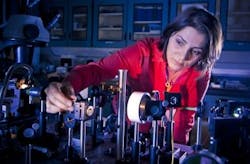UCSD scientists create nanoscale "thresholdless" laser
San Diego, CA--A group at the University of California, San Diego (UCSD) has fabricated a so-called "thresholdless" laser, which uses uses quantum electrodynamic effects to achieve lasing without a threshold using a broadband gain medium.1 The laser cavity consists of a metal rod enclosed by a ring of metal-coated semiconductor quantum wells.
The very low-power laser, which operates at room temperature and emits at telecommunications wavelengths, has a resonator of nanoscale size. It could be useful in on-chip photonic circuits, and possibly as a component in metamaterials that use laser gain to offset losses, thus making large metamaterial thicknesses more practical. As a result, larger-scale (meaning larger than a few wavelengths in size) optical invisibility cloaks may become a little less impossible (meaning not yet achievable, but a little less inconceivable than before) to build. The laser could enable metamaterial superlenses that capture evanescent light waves to image features far smaller than the diffraction limit, resulting in images of viruses and such (which is a much more realistic goal than Harry Potter style invisibility cloaks anyway).
The laser relies on quantum-electrodynamic effects in its coaxial nanocavities to get around the threshold constraint that other lasers have. The nanoscale coaxial laser is more than an order of magnitude smaller than the previous record smallest nanolaser created by UCSD and published in Nature Photonics less than two years ago. The whole device is about half a micron in diameter, and appears to be scalable to smaller sizes.
Yeshaiahu Fainman, a professor at UCSD and co-author of the new study, said other applications for the new lasers could include biochemical sensors or high-resolution displays, but the researchers are still working out the theory behind how the lasers operate. They would also like to find a way to pump the lasers electrically instead of optically.
REFERENCE:
1. M. Khajavikhan et al., Nature 482, p. 204, 09 February 2012.

John Wallace | Senior Technical Editor (1998-2022)
John Wallace was with Laser Focus World for nearly 25 years, retiring in late June 2022. He obtained a bachelor's degree in mechanical engineering and physics at Rutgers University and a master's in optical engineering at the University of Rochester. Before becoming an editor, John worked as an engineer at RCA, Exxon, Eastman Kodak, and GCA Corporation.
